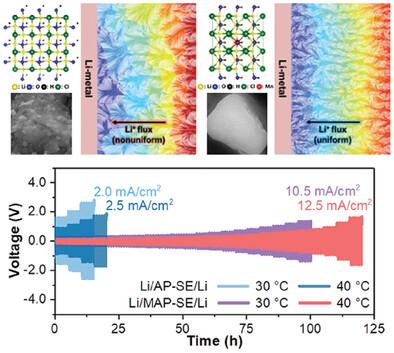当前位置:
X-MOL 学术
›
Adv. Energy Mater.
›
论文详情
Our official English website, www.x-mol.net, welcomes your
feedback! (Note: you will need to create a separate account there.)
Optimizing Atomic and Electronic Structure of Antiperovskite Solid Electrolytes for Electrochemically Stable Interface of Lithium Metal Anodes
Advanced Energy Materials ( IF 24.4 ) Pub Date : 2024-11-07 , DOI: 10.1002/aenm.202403249 Heebae Kim, Eunbin Jang, Huding Jin, Heejun Yun, Jeewon Lee, Jemin Lee, Byeongyun Min, Si Hyun Yoon, Won Jun Choi, Jeeyoung Yoo, Youn Sang Kim
Advanced Energy Materials ( IF 24.4 ) Pub Date : 2024-11-07 , DOI: 10.1002/aenm.202403249 Heebae Kim, Eunbin Jang, Huding Jin, Heejun Yun, Jeewon Lee, Jemin Lee, Byeongyun Min, Si Hyun Yoon, Won Jun Choi, Jeeyoung Yoo, Youn Sang Kim

|
Solid‐state batteries (SSBs) employing Li‐metal anodes (LMAs) show significant potential for overcoming the energy density limitations inherent in conventional Li‐ion batteries with graphite anodes. In the past decade, diverse approaches have tried to improve the cycling performance of SSBs, including chemical modifications of solid electrolytes (SEs) and designs of multifunctional interlayers. However, knowledge gaps regarding the physical characteristics of Li‐ion conducting inorganic SEs and the interfacial stability of LMAs are impeding advancements in battery technology. Herein, a practical strategy is developed to facilitate Li‐ion mobility and mitigate current constriction at the interfaces via manganese substitution into antiperovskite SEs, inspired by how liquid electrolyte additives modify the surface characteristics of LMAs. Due to the stable half‐filled 3d shell of manganese, the physically modified SE can achieve structural endurance and electrochemical compatibility with LMA. The Li symmetric cell employing this advanced SE demonstrates outstanding electrochemical performance at room temperature without external pressure. This cell configuration exhibits a high critical current density of 10.5 mA cm−2 and maintains its stable charge–discharge process over 4000 cycles at 10.0 mA cm−2 . The findings here will advance the commercialization of SSBs by providing insights into the complicated solid‐solid interactions during battery operation.
中文翻译:

优化抗钙钛矿固体电解质的原子和电子结构,实现锂金属负极的电化学稳定界面
采用锂金属负极 (LMA) 的固态电池 (SSB) 在克服传统石墨负极锂离子电池固有的能量密度限制方面显示出巨大的潜力。在过去的十年中,各种方法都试图提高 SSB 的循环性能,包括固体电解质 (SE) 的化学改性和多功能中间层的设计。然而,关于锂离子导电无机 SE 的物理特性和 LMA 的界面稳定性的知识差距正在阻碍电池技术的进步。在此,开发了一种实用策略,通过锰取代反钙钛矿 SE 来促进锂离子迁移并减轻界面处的电流收缩,其灵感来自液体电解质添加剂如何改变 LMA 的表面特性。由于稳定的半填充锰 3d 壳层,物理改性的 SE 可以实现与 LMA 的结构耐久性和电化学相容性。采用这种先进 SE 的 Li 对称电池在室温下在没有外部压力的情况下表现出出色的电化学性能。这种电池配置表现出 10.5 mA cm-2 的高临界电流密度,并在 10.0 mA cm-2 下保持其稳定的充放电过程超过 4000 次循环。这里的发现将通过深入了解电池运行过程中复杂的固-固相互作用来推动 SSB 的商业化。
更新日期:2024-11-07
中文翻译:

优化抗钙钛矿固体电解质的原子和电子结构,实现锂金属负极的电化学稳定界面
采用锂金属负极 (LMA) 的固态电池 (SSB) 在克服传统石墨负极锂离子电池固有的能量密度限制方面显示出巨大的潜力。在过去的十年中,各种方法都试图提高 SSB 的循环性能,包括固体电解质 (SE) 的化学改性和多功能中间层的设计。然而,关于锂离子导电无机 SE 的物理特性和 LMA 的界面稳定性的知识差距正在阻碍电池技术的进步。在此,开发了一种实用策略,通过锰取代反钙钛矿 SE 来促进锂离子迁移并减轻界面处的电流收缩,其灵感来自液体电解质添加剂如何改变 LMA 的表面特性。由于稳定的半填充锰 3d 壳层,物理改性的 SE 可以实现与 LMA 的结构耐久性和电化学相容性。采用这种先进 SE 的 Li 对称电池在室温下在没有外部压力的情况下表现出出色的电化学性能。这种电池配置表现出 10.5 mA cm-2 的高临界电流密度,并在 10.0 mA cm-2 下保持其稳定的充放电过程超过 4000 次循环。这里的发现将通过深入了解电池运行过程中复杂的固-固相互作用来推动 SSB 的商业化。


















































 京公网安备 11010802027423号
京公网安备 11010802027423号